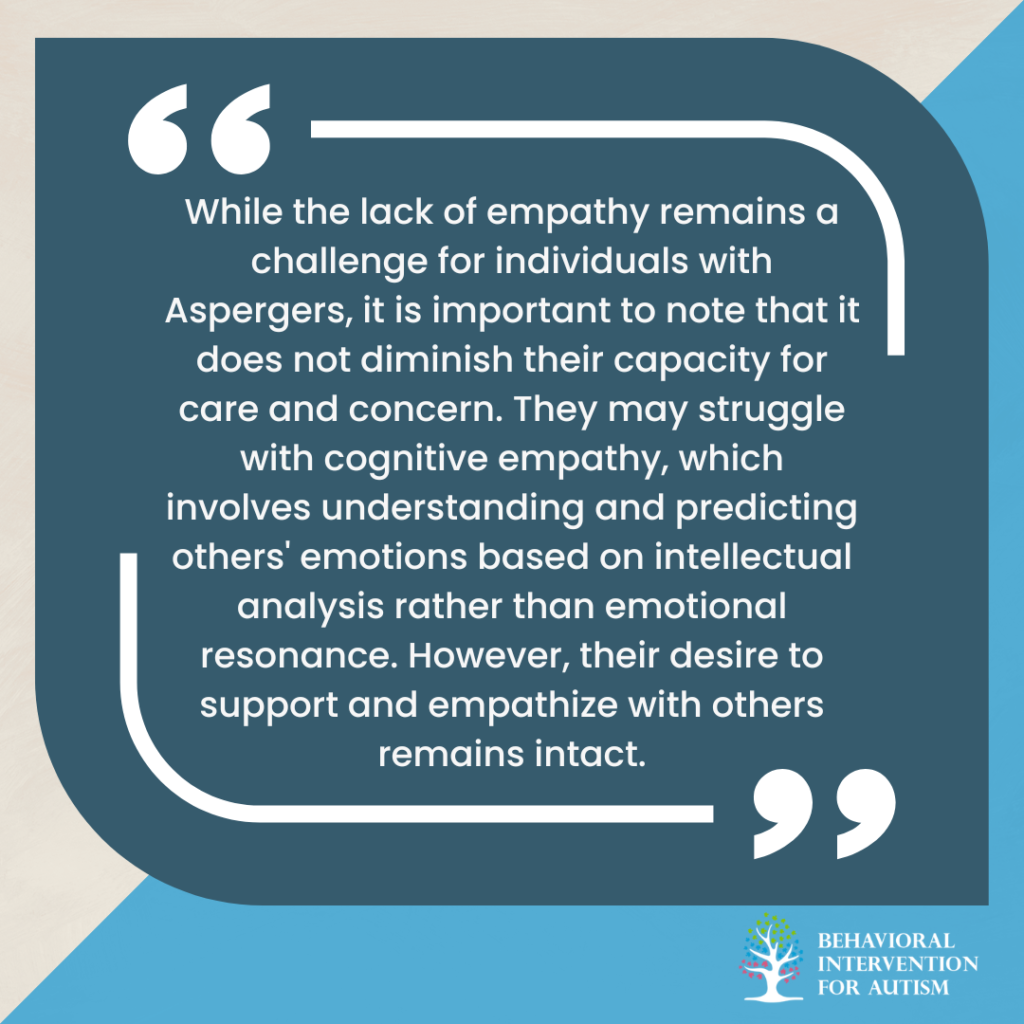
It’s important to recognize that individuals on the autism spectrum may experience empathy differently than neurotypical individuals. Empathy encompasses a range of cognitive and emotional abilities that enable us to understand and connect with others. In the case of autism, there can be challenges with cognitive empathy while affective empathy may remain intact. In-home ABA Therapy can be an effective intervention to help address these challenges.
Types of Empathy
Empathy can be broken down into different types, including cognitive empathy and affective empathy.
Cognitive empathy refers to the ability to understand and recognize another person’s emotional state. It involves interpreting and perceiving emotions in others, often through cues such as body language, facial expressions, and tone of voice. However, individuals with autism may face challenges with cognitive empathy, making it difficult for them to accurately interpret and understand the emotions of others.
Affective empathy, on the other hand, involves the ability to feel and share another person’s emotional state. It goes beyond understanding and extends to experiencing emotions alongside others. Research suggests that affective empathy may not be impaired in autistic individuals as it is primarily driven by emotional experience and response.
Challenges with Cognitive Empathy
Autistic individuals often face challenges with cognitive empathy, which can impact their ability to recognize and understand the emotions of others. These challenges may arise due to difficulties in perceiving and interpreting nonverbal cues, such as facial expressions and body language. As a result, autistic individuals may struggle to grasp the emotional context of social interactions, making it harder for them to respond appropriately.
It’s important to note that the difficulties with cognitive empathy in autism are not indicative of a lack of caring or concern for others. Rather, it reflects the differences in how emotions and social cues are processed and understood. Understanding these challenges can help foster greater empathy and support for individuals on the autism spectrum.
Additionally, it’s worth noting that over 50% of autistic individuals also experience alexithymia, a condition characterized by difficulties in understanding and articulating one’s emotions, including empathy. This further contributes to the complexities of empathy in autism.
The Double Empathy Problem
In the realm of autism, the lack of empathy experienced by individuals with Aspergers syndrome presents unique challenges in social interactions. The double empathy problem theory sheds light on the dynamics that contribute to this issue and emphasizes the importance of understanding and acceptance.
Interaction Dynamics
Research suggests that when two autistic individuals interact, there is a natural rapport and mutual understanding. They can relate to each other’s experiences and communication styles, creating a harmonious connection. However, when an autistic person interacts with a non-autistic individual, the dynamics change. Differences in communication and social cues can lead to misunderstandings and misinterpretations of empathy levels.
The double empathy problem arises from the disconnect between the autistic and non-autistic perspectives. Neurotypical individuals may struggle to comprehend the unique ways in which autistic individuals think, feel, and express themselves. Similarly, individuals with Aspergers syndrome may find it challenging to understand the social norms and expectations of the neurotypical world.
Communication Misunderstandings
One of the significant contributing factors to the double empathy problem is communication. Autistic individuals often have their own communication styles, which may involve directness, literal interpretations, and a focus on factual information. In contrast, non-autistic individuals rely more on subtle cues, nonverbal communication, and implicit meanings.
These differences in communication styles can lead to misunderstandings and difficulties in accurately perceiving and expressing empathy. Non-autistic individuals may misinterpret the intentions or emotions of autistic individuals due to the mismatched communication patterns. Conversely, individuals with Aspergers may struggle to convey their true emotions effectively, leading to misunderstandings about their feelings and empathy levels.
To bridge this gap, it is crucial for both autistic and non-autistic individuals to make an effort to understand and adapt to each other’s communication styles. Building awareness and empathy on both sides can help foster more meaningful and inclusive interactions.
Understanding the double empathy problem is a crucial step towards creating a more inclusive society that embraces the differences and challenges faced by individuals with Aspergers syndrome. By fostering empathy, acceptance, and effective communication, we can work towards bridging the gap and building stronger connections between autistic and non-autistic individuals.
Coping Strategies for Lack of Empathy
Individuals with Aspergers syndrome often face challenges with empathy, as it requires using intellect as a substitute for emotional empathy, which may be a poor alternative. However, there are coping strategies that can help individuals navigate social interactions and foster connections with others. Two key strategies for coping with the lack of empathy are cognitive substitution and creating supportive environments.
Cognitive Substitution
Cognitive substitution involves using cognitive processes to compensate for the absence of emotional empathy. This strategy allows individuals with Aspergers syndrome to rely on their intellect and logical thinking to understand and respond to others’ feelings and needs. By consciously analyzing social cues, body language, and verbal expressions, individuals can learn to recognize and interpret emotions in a more cognitive way.
While cognitive substitution may not provide the same depth of emotional understanding as natural empathy, it can help individuals with Aspergers syndrome navigate social situations more effectively. It allows them to engage in kind and caring actions, even if their emotional response may differ from what is expected. It is important to note that cognitive substitution requires ongoing effort and practice to develop and refine these cognitive skills.
Supportive Environments
Creating supportive environments is another crucial coping strategy for individuals with Aspergers syndrome. By surrounding themselves with understanding and empathetic individuals, individuals with Aspergers can gain the necessary support and guidance needed for social interactions. These supportive individuals can appreciate the unique contributions of individuals with Aspergers and help them manage any disruptive behaviors that may arise.
Supportive environments can be fostered in various settings, including family, friendships, educational institutions, and workplaces. When individuals with Aspergers syndrome are supported and accepted for who they are, they are more likely to feel comfortable and confident in social situations. This, in turn, can help them build connections and develop meaningful relationships.
It is important for parents, caregivers, and educators to create inclusive environments that promote understanding and acceptance of individuals with Aspergers syndrome. By providing appropriate accommodations, education, and social skills training, individuals with Aspergers can thrive and contribute to their fullest potential.
Sources:
https://psychcentral.com/autism/autism-and-empathy
https://www.verywellhealth.com/do-people-with-autism-lack-empathy-259887
https://www.autism-help.org/story-adult-empathy.htm
https://www.onthespectrumfoundation.org/aspergers-syndrome-and-empathy
- 9 Common Obsessions of Children With Autism You Should Know - February 25, 2025
- What is Neurodiversity? A Guide to Embracing Differences - February 25, 2025
- Understanding Hyperfocus in Autism: What It Means and Why It Happens - February 25, 2025


